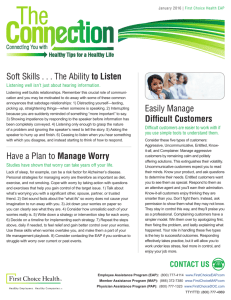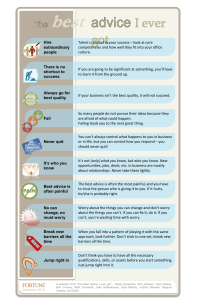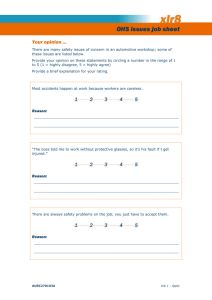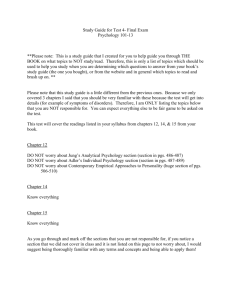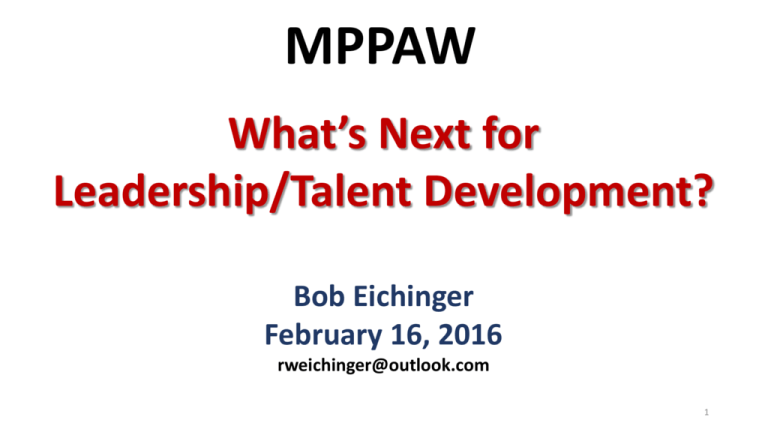
MPPAW
What’s Next for
Leadership/Talent Development?
Bob Eichinger
February 16, 2016
rweichinger@outlook.com
1
This marks my 50th year working in the field of talent management
University of Minnesota - 3
LWFW (Consultancy) in Texas - 10
PepsiCo in New York - 8
Pillsbury in Minneapolis - 2
Lominger - 15
KornFerry - 3
CCL Adjunct - 5
Semi-retired, still doing talent management since 2009
2
Leaders are mostly born
Sears/AT&T/CCL/Bass
Competencies
Of Talent and Leadership
Derailment
Development
Action learning/Simulations
70/20/10/25
9 Box Potential Matrix
PDI/DDI/CCL/SHL/Lominger/EgonZender/HayMcber/MercerDelta
EQ
Global Leadership
Learning Agility
Engagement
Coaching
Virtual Teams
Leaders are mostly made
History
3
Current State?
We know the requirements
We know the competencies
We know the derailers
We know assessment/evaluation
We know feedback/360
We know potential
4
We know coaching
We have inside/outside certified coaches
We have the Successful Manager’s Handbook
We have FYI: For Your Improvement
We have Chief Learning Officers
We know Assignmentology
5
So we have identified high potential
achievement oriented motivated adults with
verified consensus developmental
management and leadership needs and nearly
infinite advice and counsel and resources on
how to work on those needs and we have
growing roles for global leadership and
aspiring leaders to fill
So what have they done with the advice?
6
Close to nothing!!!
Many are called, but few are chosen
We are still very short
of outstanding leaders
7
So, what’s the next
thing
we need to move the efficacy
rate of manager and leader
development? How can we get
them to use more of the advice
and counsel provided?
8
What’s standing in the way of full throttle
optimized 100% successful manager and leader
development? Developing and deploying flawless
managers and leaders!!
1. The high potential candidates do not know
their needs and do not accept critical feedback
2. The candidates do not follow through on the
coaching and developmental advice and
counsel
9
Einstein - The height of insanity is doing
the same thing over and over again and
expecting something different.
Dr. Phil - If you keep doing what you’ve
been doing, you’re going to keep getting
what you’ve been getting.
10
If you don’t change
anything, nothing
will change
11
Next BIG things are:
1. help people have more accurate
insights into their own and other’s
behavior and
2. to be able to change and grow in
line with their developmental
needs and lofty leadership goals.
12
Neuroscience and Effective Leadership
NeuroLeadership
13
Until very recently, we have been mostly studying manager and
leader success and failure from the outside, observing their
behavior and trying to deduce what was going on inside.
14
During the last decade, we have begun to see
the study of what is really going on inside the
brain, in order to figure why executives (and all
people) do what they do.
Especially what’s happening when they are not
doing what we want or think they should be
doing or even what “they” want.
We are also learning how we can help them
change and become more effective.
15
It’s useful to know how the machine
(the brain) inside works that runs everything
we see on the outside
16
What do we know so far that might be helpful
for talent and leadership development?
5%
17
The Existential Brain Design
Questions
What’s the purpose of the
brain?
What’s its function?
What is it designed to do?
Why?
18
The brain’s purpose is to keep you alive in order to
replicate your genes. Every moment, your brain decides
if anything in the world around you is dangerous or
helpful or neutral. Sensing any danger can bring about
drastic changes in how you think and what you do.
Automatic responses to dangers or rewards are
thought of generally as emotions. Your ability to
regulate emotions instead of being at the mercy of
them is central to being effective.
David Rock, Your Brain at Work, Harper,
2009
19
The brain is a neural computer, designed and fitted by
natural selection with skills like computational
algorithms and reasoning and problem solving skills
related to managing our environment of plants, animals,
objects, people and artifacts. It is driven by goal states
that best served biological replication by the fittest of
our ancestors in seeking food, sex, safety, parenthood,
friendship, status and knowledge. That same toolbox is
capable of doing other things in its down time like ART
and MUSIC and being altruistic and other activities that
are of dubious adaptive value
David Rock, How the Mind Works, Norton
20
Design: The Limbic System
21
Design Specifications?
Detection of and reaction to
threat
&
Efficiency in carrying out that role
22
Why would X
behavior exist?
Why would it
have
developed? To
accomplish
what?
23
Maslow’s
Hierarchy of
Needs
Self
Actualization
Self-Esteem
Status, Respect
Love and Belonging
Relationships, Family, Intimacy
Safety and Survival
Resources, Defenses, Health
Physiological
Air, Food, Water, Sex, Sleep, Shelter, Excretion, Homeostasis
24
Design: The PFC – Pre-Frontal Cortex
25
PFC - Frontal lobes are located in front!!!, are the largest of the lobes (50% of the volume of the
cerebral hemispheres), the most prone to injury and are responsible for minor things like:
Consciousness?
Planning
Problem Solving
Executive/Impulse Control
Organizing
Memory
Decision Making
Attention
Focus
Thinking
Personality
Emotions
Left lobe – speech and language
Memories of social encounters
Right lobe – concepts, abstractions, vision, creativity
Nothing Very Important!
26
An Interesting Seesaw
Thinking Skills
Limbic System
Emotions
27
An Interesting Seesaw
Zone
Thinking
Skills
Limbic System
28
Beneath the Surface
… the limbic system … is the powerhouse of the brain – the
generator of the appetites, urges, emotions and needs that drive
most of our behaviour. Our conscience thoughts are mere
interpreters and moderators of the biologically necessary forces
from this unconscious underworld … where our conscious
processes pull in an opposite direction to emotions, the
latter is designed by the neural circuitry in our brains to
exert the stronger force.
Rita Carter, Mapping the Mind, University of California Press, 2010
29
• Tracks potential threats in thoughts,
objects, people and events – real or
imagined – from Inside or Outside
• Works on it’s own, free of
awareness on your part, .5 seconds
ahead of awareness, very
hypervigilant, more wrong than right
30
•
•
•
•
When the limbic system is activated, it can make
connection mistakes, makes links that are not there
The limbic system is a low resolution system, doesn’t
“see” details
It asks the hippocampus to go into the data
warehouse and retrieve things that look and sound the
same – it accepts too many marginal connections
As your allostatic (stress) load increases, cortisol and
norepinephrine increase and lowers your threshold for
additional threats = again see more danger where
there is none
31
• The brain is a predictive calculating
computer and prefers certainty to
uncertainty and ambiguity
• Uncertainty and ambiguity puts the
limbic system on alert
• Anything new, innovative or
different puts the limbic system on
alert and takes more energy
32
The SCARF® Trigger Model
What triggers the limbic reaction?
Away
Threats
Status
Certainty
Autonomy
Relatedness
Fairness
Towards
Rewards
David Rock, Your Brain at
Work, Harper, 2009
33
Power Stressors (allostatic load)
1.
2.
3.
4.
5.
6.
Being seen and evaluated by others in a work setting
Being seen and evaluated by others in a social setting
Rejection
Unfairness
Dealing with ambiguity and uncertainty
Having to deliver measurable results under time and resource
pressure
Result = Chronic Power Stress Reaction
Boyatzis, Smith and Blaise (2006)
David Rock (2009)
34
Use it
or lose
it
Growth Mindset
Optimism/Pessimism
Threat Desensitization
Reframing
Use it
and
change
it!
35
Automaticity
40-80% of what anyone does is automatic and
not influenced by new thinking or problem
solving
Thinking Fast and Slow, Daniel Kahneman, 2011
On Second Thought, Wray Herbert, 2010
36
Your brain has an
built-in autopilot!
And it can program and run itself!
37
Habituation
Embedded Routines
Heuristics
Automaticity
Cruse Control/Auto Pilot
38
Heuristics – the Brain on Auto Pilot/Cruise Control/ Embedded Routines
•
•
The brain faces thousands of issues and decisions everyday
If the brain had to stop and apply from scratch white board reasoning
and logic and experience and learned skills to each of those, life would
stop
• What the brain does is create shortcuts (heuristics) that execute a set of
sequenced stored automatic behaviors to do the task
• Creates automatic responses to common situations
• Takes 4-7 repetitions to form a beginning heuristic
• Examples are driving, swimming and riding a bicycle
• Everyone has 100’s of heuristics that can block effectiveness
• To change, you have to form stronger brain circuits to override existing
ones and/or create better ones
39
On Second Thought, Wray Herbert, Crown, 2010
Autopilot – the Basal Ganglia – Embedded Routines
The brain is lazy!
It has a need to be efficient!
Left to it’s own, the brain would like to make
everything we do automatic so it doesn’t have
to think (PFC) to act. It thinks the PFC is too
slow!
P300 and P500
About 40 - 80% of what people do each day are
embedded habits
40
Working
Memory
41
Working Memory - Design Flaw?
42
Your working awareness (memory)
•
•
•
•
•
•
Your capacity for holding something in your mind to work on is
surprisingly limited
The maximum “chunks” or elements of data you can focus your
awareness on at any one moment of time is about 7, some argue it’s
smaller – most likely 4 – so maybe 4-7
The number of chunks limit coming from memory is higher than the
number of new made up chunks – it’s harder for the brain to work
on things that are new and different – takes more energy
The more chunks you try to focus on, the less accurate the memories
will be - Multitasking decreases performance - Think distracted
driving
WMC – Working Memory Capacity is variable in people
WMC is been significantly related to talent and potential
43
An Infinite World
Outside
Working
Memory
4-7 channels
Choke Point
Noise
A Supercomputer
Inside
44
What clogs up working memory?
Going Limbic
Embedded Routines
Allostatic Load (Worries)
and
King TUT
45
•
•
•
•
King TUT (Task Unrelated Thoughts)
The more things on your mind, especially nonessential things and the more you are trying to
do at once, the lower your performance will be
Allostatic load (stress) decreases the
effectiveness of thinking – takes up working
memeory
Under allostatic load, the brain switches to the
basal ganglia which is the auto pilot, the cruise
control, the holder of the repetitive embedded
routines – less thinking allowed
46
So what gets in the way of being intellectually
more effective (clean unbiased use of your PFC)
and being a better executive manager leader?
Brain Design - Limbic System Activation
Nonaligned Embedded Routines
King TUT and Allostatic Load
Motivated Memories
Limits of Working Memory
Multitasking
47
48
How I see How You see
Myself
ME
49
How I see ME
Well documented
GAP
How YOU see ME
50
How I see ME = an idealized overly
positive incomplete and inaccurate self
view – partial view
How YOU see Me = ME + limbic
reactions, flawed memories, embedded
routines, self delusions – whole brain
and whole person
51
Awareness
Autopilot
52
So, what
can we
do?
53
Brain coaching/management goals
Clear working memory
Resist uncalled for limbic reactions
Resist unaligned embedded routines
Correct faulty memory and motivated reasoning
Gain more control over your reward center
Develop the patient pause
Help leaders and managers be in the zone
54
55
56
57
Many definitions
… a moment to moment awareness of the totality of
one’s experience without judgment leading to more
effective choices – a focus on attention and awareness in
order to bring mental processes under greater voluntary
control and thereby fostering better general mental well
being and the development of better specific capacities
for coping and adjusting like calmness under pressure,
clarity of thought and focused concentration on what’s
really important
58
1. Delay of gratification
2. Delay of action or reaction
3. Delay of acting long enough to
consider whether the action is the
best available at this moment
4. Being totally aware and totally in
control of your perceptions, problem
solving, actions and reactions
59
What are the benefits of
Mindfulness?
Daphne Davis and Jeffrey Hayes
in Monitor on Psychology
July/August 2012; Volume 43, Number 7
60
Among the many benefits of mindfulness
• Self control
• Objectivity
• Affect tolerance
• Enhanced flexibility
• Equanimity
• Improved concentration
• Mental Clarity
• Emotional Intelligence
• Relationship improvement
• Kindness
• Acceptance
• Compassion
61
Research based findings:
Reduced rumination leading to a larger working memory with less negative affect and less
perseverative cognitive functions resulting in more focused attention and longer
concentration powers (The Worry Program)
Stress reduction leading to less negative affect, decreased anxiety and greater emotional
regulation and selectivity (Allostatic Load)
Increased focus leading to better attention and the ability to suppress distracting
information (TUTs)
Less general emotional reactivity (Limbic (emotional) Regulation)
More cognitive flexibility and openness leading to the suppression of less useful past
learning (embedded routines)
Increased relationship satisfaction by handling conflict better and being able to share
62
emotional information
Therapeutic Efficacy Studies
Best intervention reported to be CBT
(Executive Coaching?) and Mindfulness
Why: Patient develops mental discipline
and can better carry out (act on) advice
and counsel – override the brain
63
64
The goals of the genes,
the goals of the “lower”
brain and the goals of the
mind are not always
tightly aligned
65
For most people,
your non – PFC
brain is not your
friend
66
67
Self Talk (inner voice[s])
Narrator
Evaluator
Witness
68
BrainTalk Management Tools
Labeling/Naming
Catch and Release (Don’t Engage)
The Big R Worry Management Tools
Reject/Suppress
Refocusing/Shifting Attention
Reappraisal (Normalizing/Verification)
Reinterpreting
Reordering
Repositioning
Reframing
Recontextualizing
Coaching with the Brain in Mind, David Rock, Wily, 2009
69
• Consider your brain to be a necessary but
scheming and tricky partner in your career and
life
• Your brain is part of you but it isn’t you
• Choose to manage your brain more than it
manages you – resist automaticity
• Learn and practice mindfulness
• Be the CBO of your brain
• Learn to better use your supercomputer
70
So the next things we need to do is
1. help people have more accurate
insights into their own and other’s
behavior and 2. to be able to
change and grow in line with their
developmental needs and lofty
leadership goals.
71
Coaching and
developing with the
brain in mind
Executive Mindfulness
Coaching with the Brain in Mind, David Rock, Wily, 2009
72
Primary Starter Reading List
• Thinking Fast and Slow, Kahneman, Farrar, Stauss &
Giroux, 2011
• Mapping the Mind, Rita Carter, University of California
Press, 2010
• Your Brain at Work, David Rock, Harper, 2009
• The Brain: The Story of You, David Eagleman, Pantheon,
2015
• The Unterthered Soul: a journey beyond yourself, Michael
A. Singer, Noetic Books, 2007
73
• There are over 100 TED
and Google lectures on the
brain and how the mind
works
• Watch the PBS series –
The Brain
74
Secondary Reading List
•
•
•
•
•
•
•
•
Your Brain and Business, Srinivasan S. Pillay, FT Press, 2011
On Second Thought, Wray Herbert, Crown, 2010
How the Mind Works, Steven Pinker, Norton, 2009
Coaching with the Brain in Mind, David Rock and Linda Page,
Wiley, 2009
The Power of Habit, Charles Duhigg, Random House, 2012
You are not Your Brain, Schwartz, Avery, 2011
Brain Revolution: Train Your Brain to Freedom, Gordon, 2012
Subliminal: How Your Unconscious Mind Rules Your Brain,
Mlodinow, Pantheon, 2012
75
Graphic Reading List
Mysteries of the Mind, Richard Restak, National
Geographic, 2000
Brain: The Complete Mind – How is Develops, How it
Works and How to Keep it Sharp, Michael S. Sweeney,
National Geographic, 2009
76
• NeuroLeadership Institute
www.neuroleadership.org
• NeuroLeadership Journal,
Issues one-four, 2008-2012
77
The Worry Management
Program
Using BrainTalk to Decrease the Degrading Impact of chronic
Worrying
Create a Worry Box to hold all of your worries in check
© Copyright, 2016, Robert W. Eichinger, all rights reserved
78
79
Working Memory is limited to 5-7 channels or
streams or pieces or boxes or stage positions
of material at a time to work on
“Noise” or TUT’s (task unrelated thoughts)
take up one or more of the 5-7 limited
channels and
decreases the quality of information handling
and processing and therefore slows you
down and leads to lower quality problem
solving and decision making
80
81
82
83
Worries or worrying can be good - they can alert us to possibly
important stuff we need to pay attention to and solve
Chronic worries are not good as it leads to an increase in
allostatic load (stress) and takes up a channel or more of working
memory
84
Worries become chronic when the same worries surface
repeatedly and even though you are likely to know what you need
to do to address them, you don’t
Chronic worries lead to fussing, fretting, anxiety, catastrophizing,
allostatic load and feeling apprehensive and bad
85
Common Chronic Worry Categories
1. Finances
2. Health (own and others)
3. Aging
4. Work and life stress
5. Weight management
6. Relationships (family, partners and friends)
7. Family management
8. The future
9. Ego (self) maintenance and protection
86
Time spent worrying
60,000 - 80,000 popups a day (thoughts including worries popping up in your awareness)
14.31 hours per week worrying
744 hours worrying a year
45, 243 hours of worry in a lifetime
1,885 days of worry in a lifetime
87
5.2 years of worry
Around 45% of those studied admitted stress and worry had already negatively affected their health.
Most people worry at home (65%), and over half of those who worried at home did so in the bedroom!
When asked when their principal worry times were, 55% said between 9pm at night and 3am in the morning
– the bewitching hours when your worries have the best opportunity to haunt you while sleep eludes you!
10-15% of chronic worriers develop Generalized Anxiety Disorder
Chronic prolonged worry
adds to your allostatic load, which:
• turns up your limbic system,
• turns down your digestive system,
• turns up your emergency fight or flight system,
• turns down your prefrontal cortex (thinking)
• and increases cortisol which taxes your immune
response making you more susceptible to infections
• and illnesses,
• in addition to robbing you of a good nights sleep
and peace of mind
88
Top symptoms of chronic worry
1. Sleepless nights/insomnia
2. Lost confidence/self esteem
3. Arguments with others
4. Change in appetite
5. Poorer performance at work
6. Distance from others
7. Avoiding social events
8. Increased alcohol/drug consumption
9. Digestive issues/health issues (decreased immunity)
10. Make lower quality decisions
11. Less use of brain resources (slows you down)
12. Easily distracted
13. Depression
89
Lots of worries to choose from:
Worried about the area I live in/ crime levels
Pet's health
If my dress sense is positive and working
Meeting work targets or goals
Whether I'm a good parent
Managing career correctly
A broken relationship (boss, partner, child, coworker)
90
Whether I'll find the
right partner
Whether my current partner is right
I need to find a new job
I seem to be generally unhappy
Paying rent/mortgage/debts
Job security
Financial/credit card debts
My diet
Low energy levels
Worried about my savings/financial future
Getting old in general
Chronic unhealthy worrying is
worrying about the same 9-11
things over a long period of time
and not doing anything or much to
solve the challenges and
problems to make the worries go
away
91
Astonishing Observation
Most people can help
other people solve their
worries and problems but
have trouble addressing
their own!!
92
Other people (usually trusted friends
or professional coaches, mentors or
therapists or Opra!, Dr. Phil or Dr. Oz
or Joel) can most of the time
significantly help another person
think through the action steps that
would be necessary to decrease or
eliminate a worry
93
Additional interesting
observation is that even people
with significant chronic personal
worries themselves can help
others successfully address
their worries!
94
How many Brain Parts are there?
54?
3?
How many senses?
Who is YOU?/Where are you located?
What’s awareness?
Self talk? Internal voices (Narrator, Evaluator)
Who’s listening? (Witness)
Mindfulness?
What brain parts run the worry program?
95
The Worry Management Protocol
1.
2.
3.
4.
5.
6.
7.
Name your brain parts!!! Give a name to your worry management
partners.
Write out your 9-11 recurring worries on 3 by 5 cards and Label your
worries.
Record any solutions you have come up with on the other side and put
them in your worry box or purse
Open a dialog between the Witness and your worry manager (mostly
the limbic system/amygdala)
Make the following bargain with your worry manager
“I will review my worries with you periodically at a time and place
certain, listen to your concerns, make any updates and edit any
solutions and form an action plan and take some actions”
“I would appreciate it if you (worry manager) would keep your concerns
to yourself at all other times” - be quiet!
96
8. Practice catch and release if the worry manager
surfaces worries at any other time and tell
him/her/it to stand down
9. Form a worry mutual help group with 3-5 trusted
people
10.Have periodic meetings (lunch/dinner) and each
person offer one worry for group discussion
and solution creation - record new solutions
11.Goal is to commit to an action plan to address
the worry and report back to the group on what
you did and how it worked
97
The worry group tends to be a time
limited need.
Most people tend to rapidly learn to
manage their worries more effectively.
98
Eventually, there would be no chronic
worries to discuss!!
99
BrainTalk Worry and TUT Management Tools
Labeling/Naming
Catch and Release (Don’t Engage)
The Big R Worry Management Tools
100
Reject/Suppress
Refocusing/Shifting Attention
Reappraisal (Normalizing/Varification)
Reinterpreting
Reordering
Repositioning
Reframing
Recontextualizing
Coaching with the Brain in Mind, David Rock, Wily, 2009
Goal is to decrease (even
possibly eliminate) the harmful
impact of chronic worries
causing noise in your working
memory and contributing to
allostatic load which decreases
quality of thinking
101
102
The longer term goal once you have your current worries managed is
to work hard to solve new worries as they inevitably arise for your
entire life.
First, is it real? Is it important? Is it worth paying attention to?
Can you debate it away?
103
If not:
What is the worry? What are the possible solutions? Check with your
worry support group? Pick a solution. Just do it.
Form an action plan. Do something, even small to begin to address the
worry.
104
Clear your throat!

